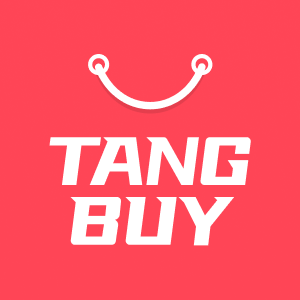Top 15 Dropshipping Software Solutions for Modern Entrepreneurs in 2025

You want to find the Best Dropshipping Software for 2025. The right choice lets you automate tasks, use smart AI features, and connect with top eCommerce platforms. These tools help you scale fast and stay ahead in a booming market. Just look at the numbers:
Year | Market Size (USD Billion) | CAGR (%) | Source |
|---|---|---|---|
2024 | $365.7 | 22% | Thunderbit Blog |
2025 | $464.4 | 27% | Thunderbit Blog |
2030 | $1,253.8 | 22% | Grand View Research |
You should consider features, pricing, automation, integrations, and how well each option fits your needs. Dropshipping software keeps evolving, so up-to-date guidance matters now more than ever.
Key Takeaways

Pick dropshipping software that matches your business size and budget. Make sure it fits your plans to grow. This helps you not pay for things you do not need.
Find tools with good automation. These tools save you time and help you make fewer mistakes. They can handle orders, stock, and customer messages well.
Check if the software works with your e-commerce platform and suppliers. It should also connect with payment systems and marketing apps. This keeps everything linked and simple to manage.
Use inventory sync features to keep your stock levels right. This stops you from selling things that are out of stock. It also keeps your customers happy.
Think about pricing plans before you choose. Try free trials or start with basic plans. Move to bigger plans as your business gets larger. This gives you the best deal.
Choose software with helpful customer support. Look for live chat, guides, and community forums. These help you fix problems fast.
Multi-channel support lets you sell on many platforms from one place. This helps you reach more customers and makes your business easier to run.
Keep your shop safe by using strong passwords and two-factor authentication. Always update your software. This protects your shop and your customers’ data.
Comparison Table

Overview
Choosing dropshipping software can be hard. There are many options. Each one has something special. Some help with automation. Others have good supplier networks or analytics. You might want a tool that fits your budget. It should work with your favourite platforms. It should help your business grow.
Let’s make it simple. The table below shows the top 15 dropshipping software. It tells you what each tool does best. You can see the price and which platforms it works with. This helps you spot the differences quickly. You can start to see which one is right for you.
Software | Key Features | Pricing Range | Integrations / Platforms | Best For |
|---|---|---|---|---|
AutoDS | Auto-ordering, repricing, analytics | eBay, Amazon, Shopify | Automation, scaling | |
Spocket | US/EU suppliers, fast shipping | From $39/mo | Shopify, WooCommerce | Quality suppliers |
Inventory Source | Inventory automation, supplier sync | Custom pricing | Shopify, WooCommerce, BigCommerce | Multi-channel sellers |
Shopify | Built-in dropshipping apps, easy setup | $39–$399/mo | Shopify App Store | Beginners, scaling |
SaleHoo | Supplier directory, product sourcing | $67/year | N/A (directory) | Product research |
DSers | AliExpress automation, bulk orders | AliExpress, Shopify, WooCommerce | AliExpress sellers | |
Modalyst | Brand suppliers, automated fulfilment | On request | Shopify, BigCommerce, Wix | Branded products |
NimbusPost | Shipping automation, courier comparison | Custom pricing | Major eCommerce platforms | Shipping optimisation |
Zapier | Workflow automation, app connections | Free–$20+/mo | 5,000+ apps, Shopify, WooCommerce | Custom automation |
Klaviyo | Email marketing, automation | Free–$60+/mo | Shopify, WooCommerce, BigCommerce | Marketing automation |
Mailchimp | Email campaigns, analytics | Free–$13+/mo | Shopify, WooCommerce, BigCommerce | Email marketing |
ActiveCampaign | CRM, email, automation | $29–$149+/mo | Shopify, WooCommerce, BigCommerce | CRM & marketing |
Drip | E-commerce marketing automation | $39+/mo | Shopify, WooCommerce, BigCommerce | Advanced marketing |
Modern Dropship | Trend-based automation, store sync | $25–$59/mo | Shopify | Trendy products |
Sellvia | US fulfilment, ready-to-sell products | $39–$399/mo | Shopify, WooCommerce | Fast US shipping |
ShipStation | Shipping, order management | $9.99–$229.99/mo | Shopify, WooCommerce, Amazon, eBay | Shipping management |
Tip: You do not need the priciest tool. Pick what your business needs now. You can always upgrade later.
Features
Every dropshipping tool has its own features. Some, like AutoDS and DSers, help with automation. They handle orders and prices for you. Spocket and Modalyst connect you to good suppliers in the US and Europe. This means your customers get faster shipping.
If you have more than one shop, Inventory Source and ShipStation help manage stock. Klaviyo, Mailchimp, and ActiveCampaign are great for marketing. They send emails and automate messages. Zapier is good if you want to link different apps.
Here are some top features you will find:
Auto-ordering and repricing: Keeps your shop current and competitive.
Supplier directories: Lets you find trusted suppliers quickly.
Bulk product import: Adds many products at once.
Inventory sync: Stops you selling things that are out of stock.
Shipping automation: Makes sending orders easy and quick.
Marketing automation: Sends emails and messages to help you sell more.
Pricing
Dropshipping software prices are very different. SaleHoo has a yearly fee. This can save money if you use it for a long time. Shopify and Sellvia have monthly plans. These plans grow as your business grows. Some tools, like DSers, Oberlo, and Zapier, have free plans or demos. You can try them before you pay.
Entry-level plans: Start at $10–$20 per month (AutoDS, DSers, Zapier).
Mid-range options: Cost about $39–$59 per month (Spocket, Modern Dropship, Drip).
Premium solutions: Can be $399 per month or more (Shopify, Sellvia, ShipStation).
One-time or annual fees: SaleHoo is $67 per year, DropshipMe has a one-time fee.
Always check if there is a free trial. This lets you test the software first. You can see if it works for you before you buy it.
Integrations
When you choose dropshipping software, you want it to work with your other tools. Integrations help you connect your shop to suppliers, marketplaces, payment systems, and social media. This lets you run your business from one place. You save time and make fewer mistakes.
Here are the main types of integrations you will see in top dropshipping software:
Integration Type | Example Tools & Details |
|---|---|
Multi-platform Selling | AutoDS works with over 8 platforms. You can manage many shops from one dashboard. |
Supplier Integrations | AutoDS lets you import from more than 30 suppliers. Spocket works with US and EU suppliers. Zik Analytics connects with about 20 suppliers. |
Social Media Ad Tracking | AutoDS Ads Spy Tool tracks Facebook, Instagram, and TikTok. Minea tracks Facebook, Instagram, TikTok, and Pinterest. |
Payment & E-commerce Platforms | Chargeflow connects with PayPal, Shopify, and Stripe for payments and chargebacks. |
You might ask, “Why are integrations important?” Here is why:
Multi-platform selling: You can sell on Shopify, WooCommerce, Amazon, and eBay. You do not need to log in to each shop. You see all your orders and products in one place. This keeps you organised.
Supplier integrations: You can add products from many suppliers with a few clicks. You do not need to copy product details. Your stock stays up to date. If a supplier runs out, your shop updates too.
Social media ad tracking: You can see which ads work best. Tools like AutoDS and Minea help you track ads on Facebook, Instagram, TikTok, and Pinterest. You can spend money on ads that bring sales.
Payment and e-commerce platforms: You can handle payments and refunds easily. Tools like Chargeflow connect with PayPal, Shopify, and Stripe. You can manage chargebacks and keep your money safe.
Tip: The more integrations your software has, the more control you get. You can automate jobs, make fewer mistakes, and focus on growing your business.
Some tools, like AutoDS, are great because they connect with many platforms and suppliers. Others, like Spocket, are good for finding top suppliers in the US and Europe. If you want to run ads, pick tools with social media tracking. For payments, check if your software links with your payment provider.
Before you decide, write down the platforms and suppliers you use now. Check if your favourite dropshipping software supports them. If you want to grow, choose a tool that can grow with you. Integrations help make dropshipping easy and less stressful.
Selection Criteria

Key Factors
When you choose dropshipping software, you want it to be right for you. You should not pay for things you do not need. You also do not want a tool that does not fit your shop. Here are the main things to check:
Feature set: The software must do what you need. It should help with product import, order fulfilment, and inventory sync.
Compatibility: It should work well with your eCommerce platform, like Shopify or WooCommerce.
Pricing structure: The price should be clear. You do not want surprise costs later.
Automation capabilities: The best tools handle inventory, orders, and shipping for you.
Scalability: Your software should grow with your business. It must handle more orders as you get bigger.
User-friendliness: You want a dashboard that is easy to use. No one wants something hard to learn.
Customer support: Good support helps your business run well, even if things go wrong.
Supplier reliability and shipping: The software should help you manage suppliers and avoid shipping problems.
Tip: Write down the features you must have before you look for software. This helps you stay focused and not get distracted by extras.
Automation & AI
Automation and AI make dropshipping much easier. They save you time and stop mistakes. The software can do boring jobs for you. This lets you spend more time growing your shop.
AI and automation can:
Update your stock right away, so you never sell things that are out of stock.
Make order processing faster by picking the best supplier and sending orders for you.
Use chatbots to answer customer questions any time.
Suggest products to customers based on what they like to buy.
Change prices quickly to keep you ahead of others.
Keep your product listings correct on all your sales channels.
Track orders and send updates to your customers without you doing anything.
With these tools, you can handle more orders and make fewer mistakes. Your customers will be happy. You do not need to worry about missing orders or running out of stock. The software does the hard work for you.
Integrations
Integrations help your dropshipping business work well. You want your software to connect with all your platforms and tools. This keeps everything working together and saves you lots of time.
Here is a quick look at the most important integrations:
Why It Matters | |
|---|---|
Marketplaces | Syncs your products and orders across Shopify, Amazon, eBay, and more. |
Suppliers | Connects directly to suppliers for real-time stock and product updates. |
Fulfilment Partners | Automates shipping with services like Amazon FBA and Deliverr. |
Inventory Sync | Keeps your stock levels up to date everywhere you sell. |
Order Management | Lets you see and manage all your orders in one place. |
Repricing Tools | Adjusts your prices automatically to stay competitive. |
Analytics & Reporting | Gives you insights to help you make smart business decisions. |
API & Data Feeds | Allows for custom connections and advanced data syncing. |
When your software has good integrations, you can sell on more channels. You can manage your stock better and keep your customers happy. You spend less time doing things by hand and more time building your brand.
Suitability
You want dropshipping software that fits your business like a glove. Not every tool works for everyone. Some platforms shine for beginners, while others suit bigger businesses with more complex needs. Picking the right one can save you time, money, and a lot of stress.
Let’s break it down. Dropshipping software comes in all shapes and sizes. Some focus on helping you start small. Others give you the power to manage many shops and suppliers as you grow. You might see free trials or budget plans for startups. These let you test the waters before you dive in. If you run a bigger shop, you’ll find advanced features and integrations that help you handle more orders and channels.
Here’s what you should think about when checking if a tool suits your business:
Business Size: Are you just starting out, or do you already have lots of orders each day? Tools like SaleHoo and Spocket work well for small businesses. They’re easy to use and don’t cost much. If you run a larger business, look at platforms like Sellercloud or TrueCommerce. These handle more orders and offer features like EDI compliance and deep integrations.
Budget: You don’t want to overspend. Many tools offer free versions or trials. For example, Inventory Source, Modalyst, and DSers let you try before you buy. This helps you see if the software fits your needs.
Ease of Use: If you’re new to dropshipping, you want something simple. WooDropship and Importify make it easy to add products and manage your shop. You won’t need to spend hours learning how things work.
Growth Plans: Think about where you want your business to go. If you plan to sell on many channels or manage lots of suppliers, pick a tool that can scale with you. Flxpoint and SellerRunning help you manage multiple stores and automate more tasks as you grow.
Support and Community: Good support makes a big difference. Look for software with helpful guides, live chat, or a strong user community. This can save you when you hit a snag.
Tip: Make a list of your must-haves. Compare software based on your business size, budget, and future plans. This way, you won’t get stuck with a tool that holds you back.
Here’s a quick table to help you match software to your business type:
Business Type | Good Software Choices | Why They Fit |
|---|---|---|
Startups & Beginners | SaleHoo, Spocket, WooDropship | Easy to use, budget-friendly, free trials |
Growing Businesses | Flxpoint, Inventory Source | Multi-channel, scalable, more automation |
Large Enterprises | Sellercloud, TrueCommerce | Advanced features, complex integrations |
Most dropshipping software targets a range of company sizes. You’ll find options whether you’re a solo entrepreneur or running a midsize business. Free trials and flexible plans make it easy to start small and upgrade as you grow. Always check if the features, price, and support match your needs. The right fit will help your business run smoothly and grow faster.
Essential Features

Automation
Automation is very important in dropshipping today. You want your business to work well, even when you are away. The right software lets technology do boring jobs for you. This means you can spend more time growing your shop.
Here are the top automation features you should look for:
Product Research and Imports: You can add many products at once. The software updates descriptions and prices for you. It uses analytics to show what sells best.
Inventory Management: Your stock syncs with suppliers in real time. You get alerts if stock is low. Updates help stop you selling too much.
Order Fulfilment: Orders go to suppliers right away. Shipping is automated. Customers get tracking updates quickly.
Customer Support: Chatbots answer common questions fast. Shoppers get help any time they need it.
Marketing: You can set up email and SMS campaigns. Reminders go out for abandoned carts. Messages are personalised to help you sell more.
Automation saves you time and helps you make fewer mistakes. You can grow your business without needing a big team.
There are also advanced features like automated payment processing. CRM integration helps you manage customers. Security tools keep your data safe. Many platforms, like Onport, connect with Shopify and WooCommerce using APIs. This gives you real-time updates and fewer manual errors.

Product Sourcing
Getting good products is very important for dropshipping. You want to sell things people want and still make money. The best dropshipping software makes finding products easy and quick.
You can see a huge list of trending products. Sometimes there are over a million choices.
You can add products to your shop with one click.
It is easy to find unique or rare products. This helps you stand out.
You get good prices, so you can keep your profits high.
US and China warehouses help you ship faster.
Automation saves you hours every week.
You can launch AI-built stores quickly.
Print-on-demand lets you offer personalised products.
Many users say product sourcing is simple and support teams are helpful. Fast sourcing, reliable fulfilment, and automation keep your customers happy. Your business runs smoothly.
Order Fulfilment
Order fulfilment is very important for dropshipping. You want every order to reach your customer quickly and easily. The best dropshipping software handles this for you.
Order processing is automated, so you do not enter details by hand.
Inventory levels sync with your shop. This stops you selling out-of-stock items.
Orders go straight to suppliers. This saves time and reduces mistakes.
Customers get shipping updates and tracking numbers automatically.
The software works with big e-commerce platforms for easy fulfilment.
For example, DSers and Inventory Source handle bulk orders and keep stock updated. Spocket and Printful sync orders and manage logistics. You can relax knowing your customers will get their items on time.
Automating fulfilment means you spend less time on admin. You can focus on growing your brand. Your customers get a better experience, and you feel less stressed.
Inventory Sync
Keeping your inventory in sync is one of the most important parts of running a dropshipping business. You want to make sure your shop always shows the right stock levels. If you sell something that is out of stock, your customers will get upset. If you miss out on sales because your listings are not up to date, you lose money. That is why you need strong inventory synchronisation features in your dropshipping software.
The best dropshipping tools do much more than just update numbers. They help you manage thousands of products and suppliers without breaking a sweat. Here is a quick look at what top inventory sync features look like:
Capability | What It Means for You |
|---|---|
Automatic import and update | Your products, images, and descriptions update themselves. No need to do it by hand. |
Customisable pricing rules | You set your profit margins. The software keeps your prices right. |
Unlimited suppliers and products | You can grow your shop as big as you want. No limits hold you back. |
Configurable sync frequency | You decide how often your inventory updates. Stay as current as you need. |
Product data customisation | Change titles, categories, and images to fit your brand. |
Re-import and force sync | If something goes wrong, you can force an update. |
Searchable product list | Find any product fast and check its sync status. |
Broad supplier support | Connect with almost any supplier, even tricky ones. |
You do not want to spend hours checking stock or updating prices. Automated inventory updates run several times a day, so your listings always show the right numbers. This stops you from selling out-of-stock items and keeps your customers happy. You can even set tiered or category pricing, which helps you stay competitive and profitable.
Here are some key benefits you will notice with good inventory sync:
You save time because the software does the hard work.
Your shop never sells products that are out of stock.
You can manage a huge catalogue of products and suppliers.
You get alerts if something needs your attention.
Your store looks professional and trustworthy.
Most dropshipping software also lets you customise your product data. You can change titles, descriptions, and images to match your brand. If you want to grow, you can add as many suppliers and products as you like. There are no limits.
Tip: Always check if your software supports real-time inventory sync. This feature can save you from many headaches and lost sales.
Some platforms even let you connect with any supplier website using advanced tools. You can use XPATH and REGEX to pull in data, even from sites that are hard to work with. This means you can always find new products and keep your shop fresh.
In short, inventory sync is your secret weapon. It keeps your business running smoothly, saves you time, and helps you avoid costly mistakes. If you want to scale your dropshipping shop, make sure your software has these features built in.
Support
When you run a dropshipping business, you will face questions and problems. Sometimes, you need help fast. That is why support is a key feature in any dropshipping software. Good support can save your day. It can even save your business.
You want to know that someone is there when you get stuck. Maybe your orders are not syncing. Maybe you cannot connect to a supplier. You do not want to wait for days to get an answer. Fast and friendly support makes your life easier.
Here are the main types of support you should look for:
Live Chat: You can talk to a real person right away. This is great when you need quick answers.
Email Support: You send your question and get a reply, usually within a few hours.
Phone Support: Some tools let you call for help. This is useful for urgent problems.
Help Centre or Knowledge Base: You can read guides, watch videos, or check FAQs. Many answers are there, so you do not need to wait.
Community Forums: You can ask other users for tips. Sometimes, you find answers from people who had the same problem.
Tip: Always check the support hours. Some companies offer 24/7 help. Others only work during business hours.
Let’s look at what good support can do for you:
Support Feature | Why It Matters |
|---|---|
Fast Response | You fix problems before they hurt your sales. |
Friendly Staff | You feel comfortable asking any question. |
Clear Guides | You learn how to use new features quickly. |
Regular Updates | You stay informed about changes and new tools. |
Community Access | You get tips from other shop owners. |
You should also look for software with lots of tutorials and step-by-step guides. These help you learn at your own pace. Some platforms even offer webinars or live training. This is great if you want to master every feature.
If you are just starting out, strong support is even more important. You will have lots of questions. You want answers that are easy to understand. Good support helps you avoid mistakes and grow your business faster.
Note: Do not forget to read reviews. Other users often share their support experiences. This gives you a real idea of what to expect.
In the end, support is not just about fixing problems. It is about helping you succeed. When you pick dropshipping software, always check the support options. You will thank yourself later when you need help and get it right away.
Best Dropshipping Software: Top Picks for 2025
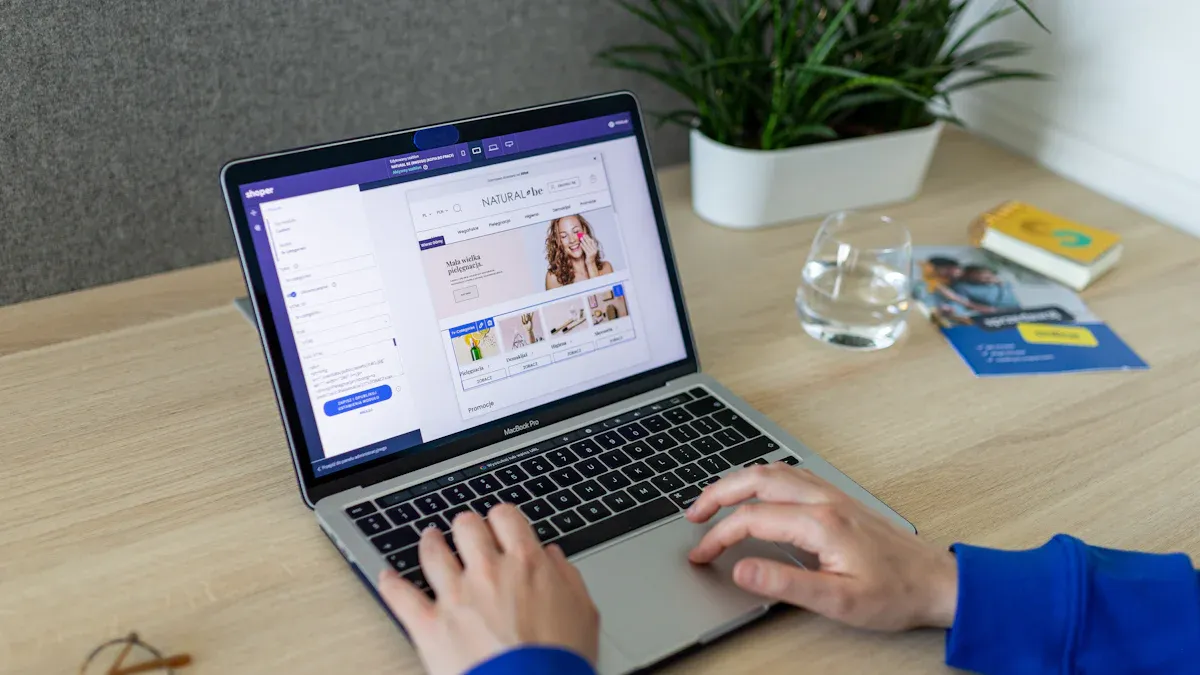
AutoDS
Features
AutoDS gives you lots of tools to help run your dropshipping shop. You can use automation for finding products, placing orders, tracking, and even returns. The platform uses AI to help you find the best products from a huge group—over 800 million items from trusted suppliers like Amazon, Walmart, and Target. You can add many products at once, set up automatic price and stock checks, and manage more than one shop from one place. AutoDS also lets you use print-on-demand and has a product research hub with over a million top-selling products. You can grow your business fast because everything works well together.
Pricing
AutoDS makes its prices easy to understand. You can start for $19.90 each month if you pay for a year, or $26.90 if you pay monthly. There are no extra hidden costs. The price includes automation, AI tools, and supplier links. You get all the main features, so you do not need to pay more for basic automation.
Integrations
You can link AutoDS to many popular platforms. It works with Shopify, eBay, TikTok Shop, Facebook Marketplace, Amazon, and WooCommerce. This means you can run several shops at the same time. You do not need to keep logging in and out of different places. The platform also lets you use print-on-demand and import from over 30 suppliers at once.
Pros & Cons
Pros | Cons |
|---|---|
Full end-to-end automation | Can feel like a lot for new users |
Built-in AI for product research and listing optimisation | Takes time to learn all the features |
Access to 800M+ products from global and private suppliers | Some features may be too advanced |
Multi-store and multi-channel support | The dashboard can look confusing at first |
Automatic price and stock monitoring | |
Print-on-demand support |
Unique Points
AutoDS is special because it gives you full automation, not just for orders but also for product research and shop management. You get AI tools that help you spot trends and grow your shop faster. Unlike many other tools, AutoDS lets you run many shops and channels from one place. You can also use print-on-demand with custom packaging. If you want the Best Dropshipping Software for automation and growth, AutoDS is a great pick.
Spocket
Features
Spocket is all about quality and speed. You get access to a group of checked suppliers, mostly from the US and Europe. This means your customers get their orders faster—usually in 2 to 5 days. Spocket checks suppliers to make sure they are good. You can order samples to test products before you sell them. The platform also gives you branded invoices and easy links to big eCommerce platforms.
Pricing
Spocket starts at $39 each month. You can pay more for extra features or more products. The price matches the quality of suppliers and the quick shipping. You can try Spocket for free before you decide.
Integrations
You can connect Spocket to Shopify and WooCommerce without trouble. Setup is fast, and you can start adding products right away. Spocket also lets you use branded invoices, which helps you build your brand and keep customers happy.
Pros & Cons
Pros:
Fast shipping from US and European suppliers (2-5 days)
High-quality, checked suppliers
Branded invoices for a professional look
Easy to link with Shopify and WooCommerce
Helpful customer support
Cons:
Costs more to start than some other tools
Not many suppliers outside the US and Europe
Fewer automation features than AutoDS
Unique Points
Spocket is different because it puts supplier quality and fast shipping first. You get good products and happy customers. The platform’s focus on clear supplier checks means you can trust what you sell. If you want the Best Dropshipping Software for quality and quick delivery, Spocket is a strong choice.
Inventory Source
Features
Inventory Source helps you automate your dropshipping shop from start to finish. You can connect with over 230 checked suppliers, most in the US. The platform automates adding products, syncing stock, and sending orders. You get real-time stock updates many times a day, so you do not sell too much. You can set your own pricing rules and change product details. The dashboard is tidy and gives you reports and analytics. This saves you time and helps you make fewer mistakes.
Pricing
Inventory Source has flexible plans. There is a free plan for small shops, but most automation needs a paid plan. Prices can be higher than some other tools, which might be hard for new or small shops. You pay more if you want better automation and more links.
Integrations
You can use Inventory Source with Shopify, WooCommerce, BigCommerce, Amazon, eBay, and Walmart. The platform works well with big e-commerce sites, but does not link as well with less common ones. Some suppliers do not support full order automation, so you might need to do some orders by hand.
Pros & Cons
Pros | Cons |
|---|---|
Big group of checked suppliers | Higher prices for small shops |
Real-time stock updates | Some orders need to be done by hand |
Automation for adding products and sending orders | Not many links with less popular sites |
You can set your own prices and product details | Product details can sometimes be mixed |
Works with many platforms | Takes time to learn for new users |
Reports and analytics tools | Support can be mixed |
Unique Points
Inventory Source stands out because it links you to a big supplier network and automates many daily jobs. You get real-time updates and can run your shop on many platforms. The platform is good if you want to grow and need strong stock management. If you want the Best Dropshipping Software for supplier choice and automation, Inventory Source is worth checking out.
Shopify
Features
Shopify is a strong platform for building your dropshipping shop. You can sell physical goods, digital files, or print-on-demand items. The app store is very big, with thousands of tools for marketing, shipping, and automation. You get smart marketing tools like email campaigns and reminders for abandoned carts. There are also links to social media. Shopify lets you change your shop’s look with many themes and design tools. You can manage orders and track stock in real time. Customers get automatic updates about their orders. Shopify supports selling on your website, social media, and marketplaces. You can do all this from one dashboard.
Shopify is not just for dropshipping. You can use it for many business types. The system is flexible and grows with your business. You also get help any time with 24/7 customer support. There is a big community if you need advice.
Pricing
Shopify has different price plans. The Basic plan starts at $39 each month. You can pay more for extra features or more staff accounts. Some apps in the Shopify App Store cost extra money. Your bill can go up if you add lots of tools. Shopify gives you a free trial, so you can try it before you pay.
Integrations
You can connect Shopify to almost any tool you want. The app store has thousands of apps for dropshipping, marketing, shipping, and analytics. You can link with top dropshipping suppliers like Oberlo, Spocket, and DSers. Shopify also works with payment gateways, accounting tools, and social media. This makes it easy to automate your shop and keep everything working together.
Pros & Cons
Pros | Cons |
|---|---|
You can change your shop with many themes and apps | Costs can go up with paid apps |
Smart marketing and automation tools | You must build your own customer list |
Real-time stock sync and order management | Some features need extra apps |
Sell on many channels and in other countries | Can be hard for beginners at first |
24/7 customer support and a big user group |
Unique Points
Shopify gives you lots of ways to grow your business. You can change your shop, automate jobs, and scale up easily. Shopify is not only for dropshipping. You can run many kinds of businesses. You get strong analytics, smart marketing, and a huge app store. If you want a platform that grows with you, Shopify is a great choice for the Best Dropshipping Software.
Shopify lets you start small and aim high. You control your brand, your products, and how you grow.
Feature | Shopify | Dedicated Dropshipping Platforms (e.g., Sellvia) |
|---|---|---|
Focus | General e-commerce platform supporting multiple business models including dropshipping | Specialised dropshipping platform focusing on product sourcing, fulfilment, and shipping logistics |
Customisation | Extensive customisation with a vast app ecosystem | Limited customisation, focused on essential dropshipping features |
Pricing | Higher cost with multiple pricing tiers and potential extra app fees | More affordable and straightforward pricing, suitable for startups and small businesses |
Customer Support | 24/7 comprehensive support via chat, email, phone | Reliable but less extensive support tailored to dropshipping needs |
Store Design & Themes | Wide variety of customisable themes and design tools | Functional themes with less variety and customisation options |
Analytics & Reporting | Robust analytics for broad e-commerce insights | Detailed reports tailored specifically to dropshipping metrics |
Scalability | Supports large inventories, multi-channel sales, and international growth | More limited scalability, focused on dropshipping operations |
Marketing Tools | Advanced marketing automation and integrations with social platforms | Basic marketing tools focused on dropshipping promotion |
Modalyst
Features
Modalyst makes running your dropshipping shop easier. It keeps your stock levels updated all the time. Orders go straight to suppliers, so you do not have to send them yourself. You can use Modalyst with Shopify, Wix, and BigCommerce. This helps you manage everything in one place.
You can put your shop’s name on packaging and labels. This helps your shop look special. Modalyst lets you choose from many suppliers in the US and other countries. Fast shipping is possible because there are warehouses close by and far away. You can also sell custom products using print-on-demand.
You can change product details, like pictures and descriptions. You set your own prices and use real-time price updates. Modalyst checks suppliers to make sure they are good. You get a dashboard to see your sales and make smart choices. The platform has eco-friendly products and gives help any time.
Key Feature | Description |
|---|---|
Automated Inventory Management | Stock updates happen right away. |
Wide Range of Suppliers | Choose from US, AliExpress, and other brands. |
E-commerce Platform Integration | Works with Shopify, Wix, and BigCommerce. |
Custom Branding Options | Add your own name to packaging and labels. |
Automated Order Fulfilment | Orders go to suppliers without you doing it. |
Real-Time Price Syncing | Prices change as the market changes. |
Product Customisation Tools | Change how products look and sound. |
Global Shipping Options | Send orders to customers anywhere. |
Supplier Vetting & Quality | Suppliers are checked for trust and quality. |
Profit Margin Control | You decide how much money you make on each sale. |
Analytics Dashboard | See your sales and what is popular. |
Flexible Subscription Plans | Pick a plan that fits your shop. |
24/7 Customer Support | Get help whenever you need it. |
Eco-Friendly Product Options | Sell products that are better for the planet. |
Fast Shipping Times | Use suppliers who deliver quickly. |
Product Sourcing Assistance | Find out which products are selling well. |
Order Tracking Capabilities | Customers can see where their order is. |
Multi-Channel Selling Support | Sell on more than one website or shop. |
Customisable Pricing Rules | Change prices to match what is happening in the market. |
Access to Exclusive Products | Sell special items that are hard to find elsewhere. |
Pricing
Modalyst has a free plan if you want to try it. Paid plans start at about $35 each month. The price goes up if you want more products or features. You can pick a plan that matches your shop size. This makes Modalyst good for small and growing shops.
Integrations
You can link Modalyst to Shopify, Wix, and BigCommerce. It is easy to set up. You can add products with just a few clicks. Modalyst works with print-on-demand and lets you sell on more than one shop. You can control everything from one dashboard.
Pros & Cons
Pros | Cons |
|---|---|
Easy to use for stock and orders | Some features cost more money |
Lots of suppliers, including US and Europe | Not many links outside main platforms |
Custom branding and print-on-demand | Free plan limits how many products you get |
Fast shipping and eco-friendly choices | Some suppliers may charge higher prices |
Help is always available |
Unique Points
Modalyst is great because it saves you time with automation. You can add new products and suppliers without much work. You can make your shop look special with your own packaging. There are special and eco-friendly products to choose from. Modalyst is free to start, so it is easy for new shops. If you want a tool that grows with your shop and keeps things simple, Modalyst is a good choice for dropshipping.
Klaviyo
Features
Klaviyo helps you send emails and texts to your customers. You can set up messages that go out when people do certain things. For example, if someone leaves a basket, Klaviyo can remind them. You use a simple builder to make your emails look nice. You can put customers into groups by what they buy or if they use coupons. Klaviyo uses AI to guess when someone might shop again. This helps you send messages at the best time. You get reports that show what is working and what you should change.
Easy automation with your own rules
Drag-and-drop email builder with ready designs
Make groups of customers for special messages
See reports and results right away
Pricing
Klaviyo has a free plan for small lists. If you have more people, you pay more. Prices start at about £20 each month for emails only. The price goes up if your list gets bigger or you add texts. You can try it for free before you pay.
Integrations
You can link Klaviyo to Shopify, WooCommerce, Magento, and more. It works with most online shop tools. You can also connect it to Facebook, Google Ads, and other marketing apps. This means you can do all your marketing in one place.
Pros & Cons
Pros | Cons |
|---|---|
Can be hard for new users | |
Smart AI features | No lead scoring built in |
Works well with Shopify and Magento | Price goes up as your list grows |
Custom emails and texts | Takes time to learn everything |
See results quickly |
Unique Points
Klaviyo is special because it uses AI to help your marketing. You can send messages when people are most likely to buy. The automation lets you set up steps for every part of shopping. If you want smart marketing for your dropshipping shop, Klaviyo is a top pick.
Mailchimp
Features
Mailchimp is good for beginners and small shops. The dashboard is simple and easy to use. You can build emails with easy tools. You can set up basic messages, like welcome emails or birthday offers. The journey builder helps you make simple email paths. Mailchimp gives you reports to see how your emails do. There are some AI tools that give you tips and ideas.
Simple to use
Basic automation for email series
Journey builder for easy email paths
AI gives you ideas for content
Over 200 app links
Pricing
Mailchimp has a free plan for small lists. Paid plans start at about £13 each month. The price goes up if your list gets bigger or you want more features. The free plan is good if you are just starting. You can upgrade later as your shop grows.
Integrations
Mailchimp links with over 200 apps, like WooCommerce, BigCommerce, and many CRMs. It does not link straight to Shopify. You need another app to use it with Shopify. You can still connect it to social media and other marketing tools.
Pros & Cons
Pros | Cons |
|---|---|
Very easy to use | No direct link to Shopify |
Good price for small shops | Automation is simple |
Good reports and results | Not many advanced features |
Lots of app links | Not great for tricky email paths |
AI gives you content tips |
Unique Points
Mailchimp is great if you want something simple and cheap. You can start fast and learn as you go. It is best for basic email marketing and easy automation. If you have a small dropshipping shop, Mailchimp is a good choice.
ActiveCampaign
Features
ActiveCampaign gives you email marketing, CRM, and automation in one. You can build customer journeys with a visual builder. You can score leads, track visits, and send emails based on actions. You can make groups for special messages. ActiveCampaign also lets you send texts and has strong reports. The built-in CRM helps you manage contacts and sales.
Visual builder for automation
Lead scoring and CRM tools
Make groups and set triggers
Email and text marketing
Detailed reports and analytics
Pricing
ActiveCampaign starts at about £29 each month for the basic plan. The price goes up if you want more features or have a bigger list. You can try it for free before you pay. The plans work for both small and growing shops.
Integrations
You can link ActiveCampaign to Shopify, WooCommerce, BigCommerce, and more. It also connects to CRMs, payment tools, and social media apps. This helps you keep all your marketing and sales together.
Pros & Cons
Pros | Cons |
|---|---|
Strong automation and CRM | Can be too much for new users |
Visual builder for journeys | Higher price for more features |
Deep groups and targeting | Hard to learn for tricky paths |
Email and text in one place | |
Good links to other tools |
Unique Points
ActiveCampaign is good if you want more than just email marketing. You get CRM, automation, and strong targeting in one tool. The visual builder makes it easy to see your customer journeys. If you want to grow your dropshipping shop and need strong automation, ActiveCampaign is a smart choice.
Drip

Features
Drip helps you connect with your customers. You can send emails and SMS that feel personal. It is easy to set up automated campaigns. You can see what your customers do on your website. Drip lets you make special journeys for each shopper. You can use tags and groups to sort your audience. The visual builder makes automation simple. You get reports to see what works best.
Drag-and-drop email builder
Ready-made templates for quick use
Advanced ways to group and tag people
See what customers do right away
SMS marketing with email
Product suggestions for each person
Test different emails to see what works
Drip helps you sell more by knowing your customers. You can use it to bring back people who left their carts. You can welcome new shoppers and send special deals.
Pricing
Drip has a simple way to charge you. You pay for how many people are on your email list. Prices start at about $39 each month for up to 2,500 people. If your list gets bigger, you pay more. All plans let you send as many emails as you want. You get automation and support too. You can try Drip free for 14 days.
Integrations
Drip works with many e-commerce platforms. You can link it to Shopify, WooCommerce, Magento, and BigCommerce. It also works with Zapier, Facebook, and Google Ads. You can connect Drip to your favourite tools for payments, analytics, and support. This keeps all your marketing in one place.
Pros & Cons
Pros | Cons |
|---|---|
Simple for beginners to use | Costs more if your list is big |
Strong automation and grouping | No landing page builder included |
Works with top e-commerce platforms | SMS costs extra money |
Good help and learning guides | Some things take time to learn |
See what is happening right away |
Unique Points
Drip is special because it is made for online shops. You get tools just for e-commerce, not just normal email marketing. The platform helps you send the right message at the right time. You can use both email and SMS together. Drip’s automation builder is easy but powerful. If you want to grow your shop with smart marketing, Drip is a good choice.
Modern Dropship

Features
Modern Dropship helps you find and sell popular products fast. You get a dashboard that shows what is trending now. The platform adds new products to your shop every day. You can import items with one click. Modern Dropship checks suppliers to make sure they are good. You can set your own prices and change product details. The system keeps your stock levels updated. You can manage orders and track shipping from one place.
Find trending products easily
New items added every day
Import products with one click
Checks suppliers for quality
Stock updates automatically
Tools to manage orders
Change product listings as you like
Modern Dropship helps you keep up with trends. You can always offer the newest products to your customers.
Pricing
Modern Dropship has simple plans. Prices start at $25 each month. You can pay more for extra features or more products. There is a free trial so you can test it first. The plans work for small and growing shops.
Integrations
You can connect Modern Dropship to Shopify. Setup is quick and easy. You can add products to your shop in minutes. More integrations will come soon. For now, it works best with Shopify.
Pros & Cons
Pros | Cons |
|---|---|
Quick access to trending products | Only works with Shopify |
New products every day | Not as many integrations as others |
Easy for beginners to use | Smaller group of suppliers |
Orders and stock update automatically | Fewer advanced features |
Free trial to try it out |
Unique Points
Modern Dropship is special because it focuses on trends. You can spot what is popular and add it to your shop fast. The platform is simple and quick to use. If you want to sell the latest products and keep your shop fresh, Modern Dropship is a good pick.
Sellvia
Features
Sellvia gives you a full dropshipping solution with fast US shipping. You get a list of products ready to sell. The platform sends orders from US warehouses. You can add products to your shop with one click. Sellvia checks suppliers for quality. You can use your own branding on packaging. The system updates your stock and prices for you. You get marketing materials for each product. Sellvia can help set up your shop if you need it.
Fast US shipping (1-3 days)
One-click product import
Ready-to-sell product list
Orders sent automatically
Custom branding options
Marketing kits for products
Help with shop setup
Sellvia helps you deliver products quickly and build your brand.
Pricing
Sellvia has clear prices. Plans start at $39 each month for the basic package. You can pay more for extra features or a custom shop. There is a 14-day free trial. You can try it before you decide.
Integrations
You can connect Sellvia to Shopify and WooCommerce. The connection is smooth. You can manage products, orders, and stock from your shop’s dashboard. Sellvia takes care of fulfilment and shipping for you.
Pros & Cons
Pros | Cons |
|---|---|
Fast shipping from US warehouses | Only ships from the US |
Easy to import products | Not many options outside the US |
Custom branding for your shop | Product list may feel small |
Marketing materials included | Higher price for more features |
Help with setting up your shop |
Unique Points
Sellvia is special because it focuses on fast US shipping. You can give your customers quick delivery and branded packaging. The platform gives you everything you need to start selling right away. If you want a dropshipping solution with fast fulfilment and strong support, Sellvia is a top choice.
ShipStation

Features
ShipStation helps you manage shipping and orders for your dropshipping shop. You can see all your orders in one place. The dashboard is easy to use. You can print shipping labels with just a few clicks. ShipStation lets you compare shipping rates from different couriers. You can pick the best price every time.
You can set up rules to automate shipping tasks. For example, you can choose which courier to use for certain products. You can also send tracking numbers to your customers automatically. ShipStation supports batch processing. This means you can print many labels at once. You save time when you have lots of orders.
You get branded labels and packing slips. Your shop looks professional. ShipStation also gives you reports. You can see how much you spend on shipping and which couriers work best for you.
Tip: Use automation rules to save time and avoid mistakes when you ship lots of orders.
Pricing
ShipStation offers several plans. The cheapest plan starts at $9.99 per month. This plan works for small shops with up to 50 shipments each month. If you have more orders, you can choose a bigger plan. The most expensive plan costs $229.99 per month. This plan is for large businesses with thousands of shipments.
All plans include core features like order management, automation, and branded labels. You can try ShipStation free for 30 days. This helps you see if it fits your shop before you pay.
Integrations
ShipStation connects with many e-commerce platforms. You can link it to Shopify, WooCommerce, Amazon, eBay, BigCommerce, and more. It also works with over 40 shipping carriers, such as Royal Mail, UPS, FedEx, DHL, and Hermes.
You can connect ShipStation to your accounting tools and inventory systems. This keeps your business organised. You do not need to enter data by hand. ShipStation also links with marketplaces and shopping carts. You can manage all your orders from one dashboard.
Pros & Cons
Pros | Cons |
|---|---|
Easy to use dashboard | Some plans cost a lot |
Supports many platforms and couriers | Can feel complex for new users |
Strong automation for shipping tasks | Some features only in higher plans |
Batch label printing saves time | No product sourcing or supplier tools |
Branded labels and packing slips | |
Good reports and analytics |
Unique Points
ShipStation stands out because it focuses on shipping and order management. You can handle orders from many shops and marketplaces in one place. The automation rules help you save time. You can print labels in bulk and send tracking updates without extra work.
ShipStation works with many couriers and platforms. You can always find the best shipping rate. The branded labels and packing slips help your shop look professional. If you want to make shipping easy and keep your customers happy, ShipStation is a smart choice for your dropshipping business.
Comparison by Needs

For Beginners
Starting dropshipping can seem hard at first. The right software makes it much easier. You want something simple and not too expensive. It should be reliable as well. Good beginner platforms help you learn step by step. You will not get lost with too many features.
Here are some top picks for beginners:
Platform | Why It’s Good for Beginners | Key Pros | Key Cons |
|---|---|---|---|
DSers | Easy to use, works with AliExpress | Simple interface, bulk order automation | AliExpress focus, some paid features |
AliExpress | Great for small budgets | Huge product range, low prices | Slow shipping, mixed product quality |
Wholesale2B | Automation and variety | Wide range, multi-platform integration | Subscription fees, slower shipping |
Wholesale Central | Manual but free to use | No fees, lots of suppliers | No automation, old interface |
Dropified | More for experienced users | Automated fulfilment, research tools | Expensive, steep learning curve |
If you are new, DSers and Wholesale2B are good choices. DSers has a friendly dashboard. You can handle many orders at once. Wholesale2B gives you automation and works with different shops. AliExpress is also popular for beginners. You do not need much money to start. But shipping can take longer.
Tip: Try a free plan or demo before you pay. This helps you see if the software is right for you.
For Scaling
When your shop gets bigger, you need stronger software. You want tools that can handle more orders and products. They should connect with many suppliers. Automation and integration become very important now.
Here is a table with some top choices for growing shops:
Software | Key Features | Best For | Starting Price |
|---|---|---|---|
Flxpoint | Multi-supplier, advanced automation | High-volume sellers | $499/month |
Zendrop | Fast US shipping, private labelling | Growing shops needing speed | $49/month |
AutoDS | Multi-platform, price and stock monitoring | Streamlining and automation | $19.90/month |
Spocket | US/EU suppliers, branded invoicing | Reliable, fast shipping | $39.99/month |
Inventory Source | 230+ suppliers, order routing | Efficient scaling | $99/month |
DSers | Bulk orders, AliExpress integration | Handling large product lists | $20/month |
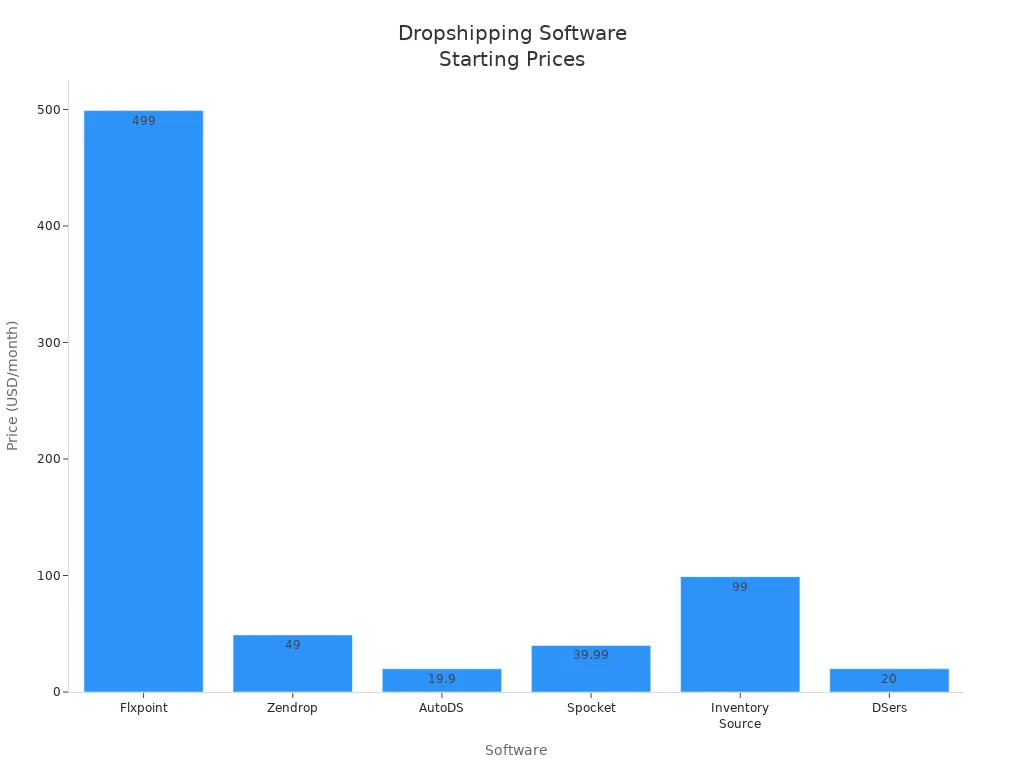
If you want to grow quickly, Flxpoint gives you lots of control. It works with many suppliers. Zendrop and AutoDS help you automate orders and keep your stock updated. This means less manual work for you. Spocket and Inventory Source are good for reliable suppliers and easy shop connections.
As your business grows, automation and integration save you lots of time. You can focus on getting more sales instead of fixing problems.
For Automation
Automation helps you save time and avoid mistakes. The right software handles orders, stock, and customer messages for you. You do not have to do everything yourself.
Platforms like AutoDS, DSers, and Zendrop are great for this. They let you:
Process orders automatically, even in bulk.
Sync inventory in real time, so you never sell out-of-stock items.
Update prices when suppliers change them.
Send tracking numbers to customers without extra work.
Some tools use AI to suggest products or spot trends. This helps you react fast to what is selling. Automation lets you handle more orders as your shop grows. You do not need a big team.
If you want to grow your dropshipping business, choose software that automates as much as possible. You will have more time for marketing and building your brand.
For Multi-Channel
Do you want to sell on more than one platform? Multi-channel dropshipping helps you reach more customers. You can list your products on Shopify, Amazon, eBay, WooCommerce, and even social media shops. This way, you do not put all your eggs in one basket. If one shop slows down, the others can keep your sales going.
Why go multi-channel?
You get more eyes on your products.
You can test which platform works best for your shop.
You protect your business if one channel has problems.
You can grow your brand faster.
But managing many shops can get messy. You might worry about stock levels, orders, and prices. That is where the right dropshipping software steps in. It keeps everything in sync. You do not need to update each shop by hand.
Tip: Choose software that lets you manage all your shops from one dashboard. This saves you time and stops mistakes.
Here’s a quick look at some top picks for multi-channel dropshipping:
Software | Multi-Channel Support | Key Benefit |
|---|---|---|
AutoDS | Shopify, eBay, Amazon, more | One dashboard for all shops |
Inventory Source | Shopify, WooCommerce, Amazon, eBay | Real-time stock sync |
ShipStation | Shopify, WooCommerce, eBay, Amazon | Easy shipping for all channels |
Sellvia | Shopify, WooCommerce | Fast US fulfilment on both |
Flxpoint | Handles big catalogues |
You do not need to be a tech expert. Most of these tools have simple dashboards. You can see all your orders, stock, and sales in one place. If you sell out on one channel, the software updates your other shops. This stops you from selling items you do not have.
What should you look for?
Easy setup for each channel
Real-time inventory sync
Order management for all shops
Simple reports to track your sales
Note: Some platforms charge extra for more channels. Always check the plan details before you sign up.
Multi-channel dropshipping gives you more freedom. You can try new markets and see what works. With the right software, you can grow your business without extra stress. If you want to reach more customers and keep things simple, go multi-channel. The right tool makes it easy.
Common Concerns

Automation
You might wonder if automation will really make your dropshipping life easier. The answer is yes, but only if you pick the right software. Automation helps you save time and avoid mistakes. You do not have to update stock or send orders by hand. The software does it for you.
Here are some things automation can do for you:
Sync your inventory so you never sell out-of-stock items.
Place orders with suppliers as soon as a customer buys.
Update prices if your supplier changes them.
Send tracking numbers to your customers.
Tip: Start with basic automation. You can add more features as your business grows.
Some tools offer full automation. Others only help with a few tasks. Always check what the software can automate before you sign up. If you want to grow your shop, automation is your best friend.
Compatibility
Compatibility means your dropshipping software works well with your shop and other tools. You want everything to connect smoothly. If your software does not fit, you will waste time fixing problems.
Ask yourself these questions:
Does the software work with your e-commerce platform (like Shopify or WooCommerce)?
Can you connect it to your favourite payment gateways?
Will it link with your marketing tools, such as email or SMS apps?
Does it support the suppliers you want to use?
Here is a quick table to help you check compatibility:
What to Check | Why It Matters |
|---|---|
E-commerce platform | Easy setup and management |
Payment gateways | Smooth checkout for buyers |
Supplier connections | Fast product sourcing |
Marketing tools | Better customer engagement |
Note: Always test integrations with a free trial. This helps you spot problems early.
Costs

You want to know how much dropshipping software will cost you. Prices can vary a lot. Some tools have free plans. Others charge monthly or yearly. You might also pay extra for more features or users.
Here are some common costs:
Monthly fees: Most tools charge each month. Prices start low but can rise as you add features.
Transaction fees: Some platforms take a small cut from each sale.
Add-ons: You might pay more for extra automation, more products, or better support.
You should always check what is included in the price. Look for hidden fees. Try to pick a plan that matches your business size. If you are just starting, a free or basic plan is often enough.
Alert: Do not pay for features you do not need. Upgrade only when your business grows.
Costs matter, but the right software can save you money in the long run. Automation and good support help you avoid costly mistakes. Always balance price with value.
Security
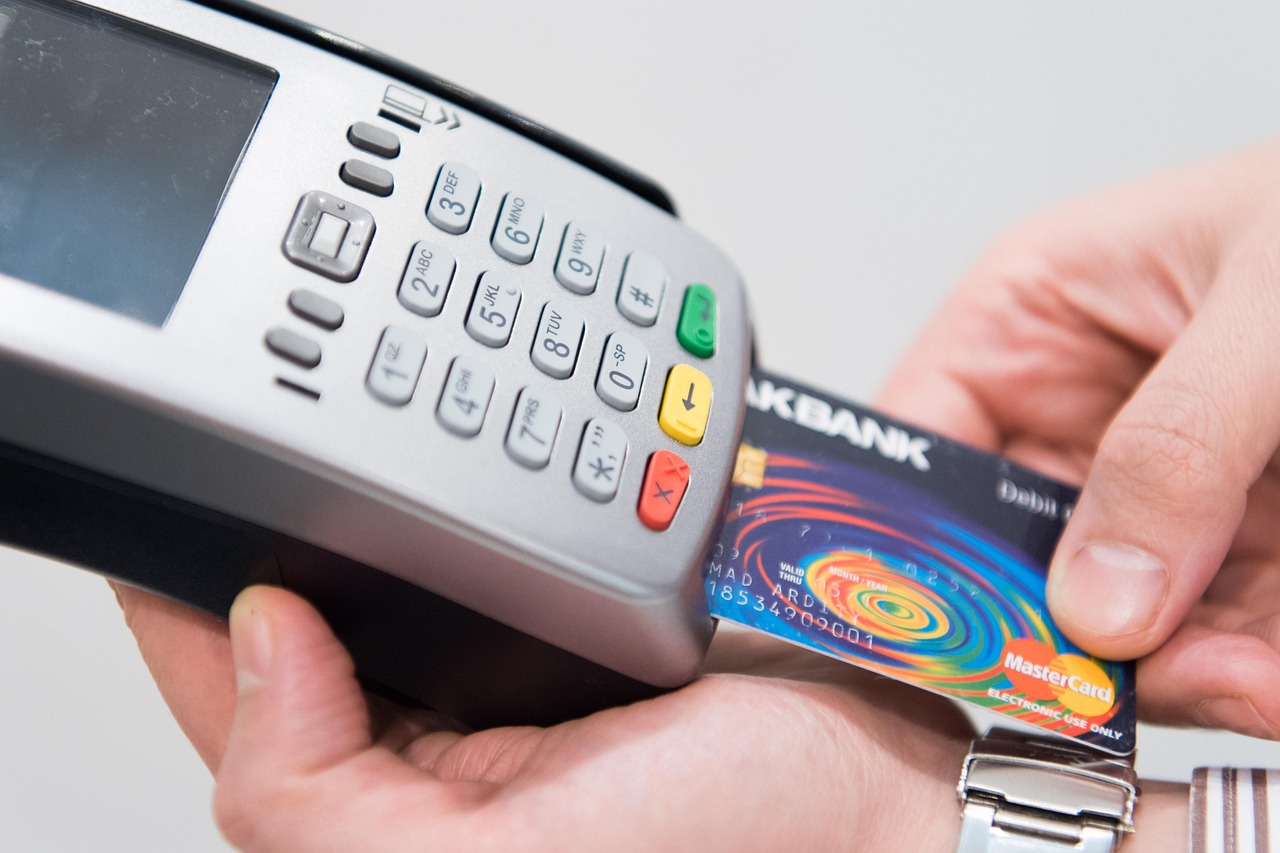
You might not think about security when you first start dropshipping, but it matters a lot. Your shop holds customer data, payment details, and business secrets. If you do not protect these, you could lose money or even your whole business. Let’s talk about the most common security risks you face with dropshipping software and how you can keep your shop safe.
Here are some of the biggest security threats you need to watch out for:
Phishing: Hackers pretend to be someone you trust. They might send fake emails or messages to trick you or your customers into sharing passwords or card details.
Spam: You might get messages with bad links. These can come through email, blogs, or even social media. Clicking them can harm your website or steal your data.
Bots: Some people use bots to scrape your prices and stock levels. They can use this information to mess with your sales or copy your products.
Brute Force Attacks: Hackers try to guess your admin password by trying lots of combinations. If your password is weak, they might get in.
Malware and Ransomware: These are nasty programs that can steal your customer data or lock you out of your own shop until you pay a ransom.
You do not have to feel helpless. You can take simple steps to protect your dropshipping business. Start by using strong passwords. Change them often and never use the same password for everything. Turn on login alerts so you know if someone tries to get into your admin panel from a strange place.
Always use HTTPS with SSL certificates. This keeps your customers’ data safe when they buy from your shop. Firewalls help block bad traffic and stop hackers from sneaking in. Antivirus and anti-malware software can spot fake transactions and keep your customer data safe.
A good idea is to use multi-factor authentication. This means you need more than just a password to log in. It makes it much harder for hackers to break in. You should also update your plugins and software often. Updates fix holes that hackers might use to get in.
Don’t forget to back up your data. Use the 3-2-1 rule: keep three copies, on two types of storage, with one copy offsite. If something goes wrong, you can get your shop back up fast.
Train your team about security. Make sure everyone knows not to click on strange links or share passwords. You might even want to use a zero-trust approach. This means you never trust anyone by default, even inside your business.
Tip: Security is not just about tools. It’s about habits. Stay alert, update often, and teach your team to do the same. Your business will thank you.
Recommendations

Choosing Software
Picking the right dropshipping software can feel tricky. You want a tool that fits your business, your budget, and your plans for growth. Here’s how you can make a smart choice:
List Your Needs
Write down what you want your software to do. Do you need automation? Are you looking for fast shipping? Do you want to sell on many platforms? This list will help you stay focused.Set Your Budget
Decide how much you want to spend each month. Some tools have free plans. Others cost more but offer extra features. Remember, you do not need the most expensive option to start.Check Integrations
Make sure the software works with your shop, payment systems, and suppliers. If you use Shopify or WooCommerce, check for easy connections.Read Reviews
Look at what other users say. Reviews can show you the good and the bad. You might spot problems before you sign up.Think About Growth
Choose software that can grow with you. If you plan to add more products or shops, pick a tool that can handle it.
Tip: Make a table to compare your top choices. List features, prices, and integrations side by side. This makes it easy to see which one fits best.
Software | Key Features | Price | Integrations | Best For |
|---|---|---|---|---|
AutoDS | Full automation | £20/mo | Shopify, eBay | Scaling up |
Spocket | Fast shipping | £32/mo | Shopify, Woo | Quality products |
DSers | AliExpress focus | £16/mo | Shopify, Woo | Beginners |
Getting Started
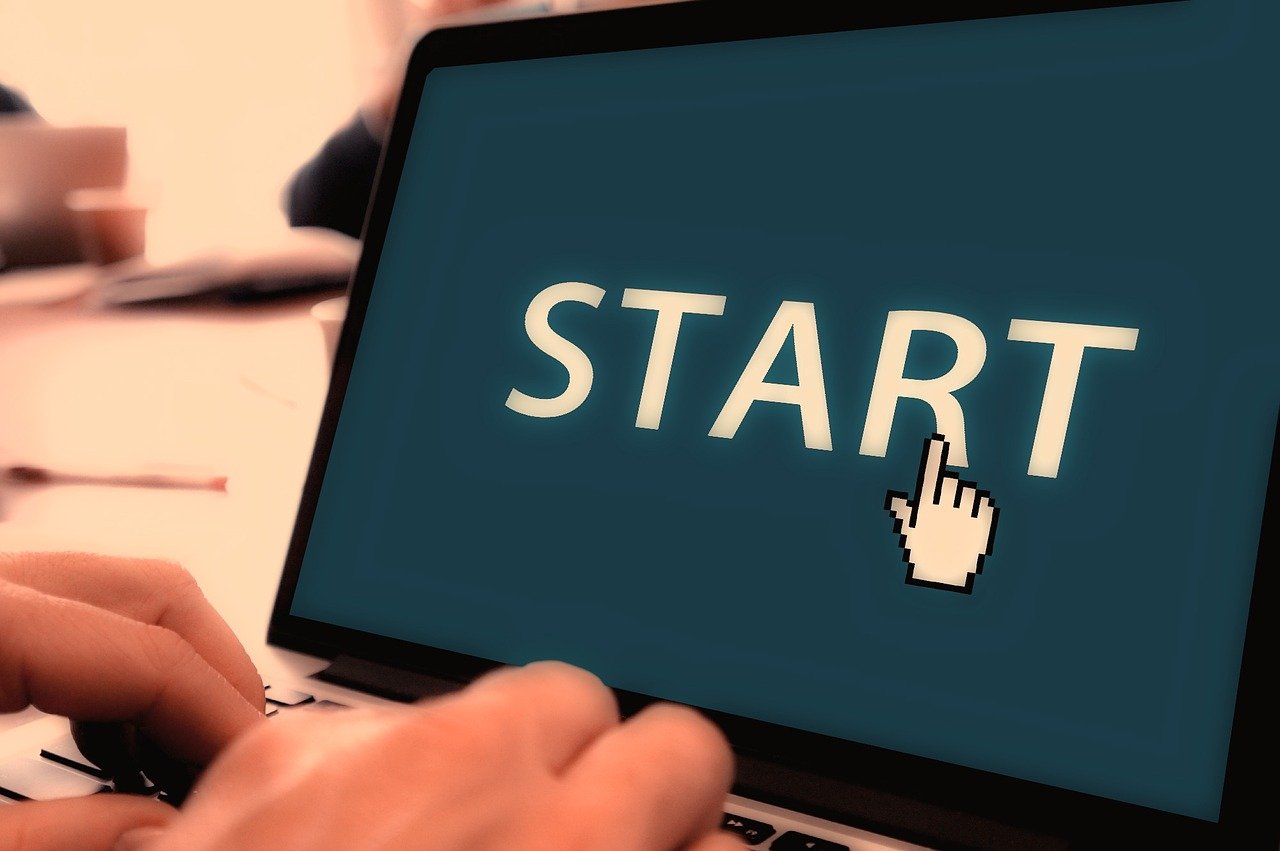
Once you pick your software, you want to get up and running fast. Here’s how you can start with confidence:
Sign Up for a Free Trial
Most dropshipping tools offer a free trial or demo. Use this time to test the dashboard and features. Try importing a few products and placing a test order.Follow Setup Guides
Many platforms have step-by-step guides or videos. These help you connect your shop, add products, and set up automation. Take your time and follow each step.Start Small
Add a few products first. Learn how the system works. You can always add more later.Check Support Options
If you get stuck, use live chat or email support. Good support can save you hours.
Note: Do not rush. Spend time learning the basics. A strong start helps you avoid mistakes later.
Maximising Value
You want to get the most from your dropshipping software. Here are some ways to make sure you get great value:
Use Automation
Let the software handle orders, stock updates, and tracking. This saves you time and stops errors.Explore All Features
Try out marketing tools, analytics, and reports. These can help you spot trends and grow your sales.Keep Learning
Join user groups or forums. Watch webinars or read new guides. The more you know, the better your shop will run.Review Your Plan
As your business grows, check if you need to upgrade your plan. More features can help you scale faster.Stay Secure
Use strong passwords and update your software often. This keeps your shop and your customers safe.
🚀 Remember: The best dropshipping software is the one that fits your needs and helps you grow. Try free trials, ask questions, and keep learning. You will build a shop you are proud of!
Choosing the right dropshipping software can make or break your business in 2025. You want tools that save you time, boost your sales, and help you grow. Automation, AI, and strong integrations give you a real edge. Use the tables and tips in this guide to find your perfect match.
Ready to take action? Try a free trial or demo today and see which platform fits you best! 🚀

FAQ
What is dropshipping software?
Dropshipping software helps you run your online shop. You can find products, add them to your store, and send orders to suppliers. The software automates many tasks, so you save time and avoid mistakes.
Can I use dropshipping software if I am a beginner?
Yes, you can. Many tools have simple dashboards and guides. You can start with free trials. You do not need special skills. The software walks you through each step.
How much does dropshipping software cost?
Prices vary. Some tools offer free plans. Others start at about £10 per month. You might pay more for extra features or more products. Always check for hidden fees before you sign up.
Do I need to know how to code?
No, you do not. Most dropshipping software works with clicks and menus. You can set up your shop without coding. If you get stuck, support teams can help you.
Will dropshipping software work with my shop platform?
Most top tools work with Shopify, WooCommerce, and other big platforms. Always check the integrations list before you choose. You want your software to connect easily.
Can dropshipping software help me with marketing?
Yes, it can. Many tools send emails, track ads, and help you follow up with customers. You can use built-in marketing features or connect to apps like Klaviyo or Mailchimp.
Is my customer data safe with dropshipping software?
Good dropshipping software uses strong security. You get SSL, data encryption, and regular updates. Always use strong passwords and turn on two-factor authentication for extra safety.
Tip: Always read reviews and try a free demo before you decide. This helps you find the best fit for your shop.

TangBuy: A Smarter Way to Dropship in 2025
If you're looking to stay competitive with dropshipping in 2025, speed and trend-awareness are key. TangBuy helps you stay ahead with real-time product trends, fast fulfilment, and factory-direct sourcing. With over 1 million ready-to-ship items, 24-hour order processing, and seamless Shopify integration, TangBuy makes it easier to test, scale, and succeed in today's fast-moving eCommerce landscape.
See Also
Essential Dropshipping Applications Every Shopify Store Needs Today
Profitable Dropshipping Concepts To Earn Income In 2025
High-Gain Dropshipping Markets To Target In 2025
